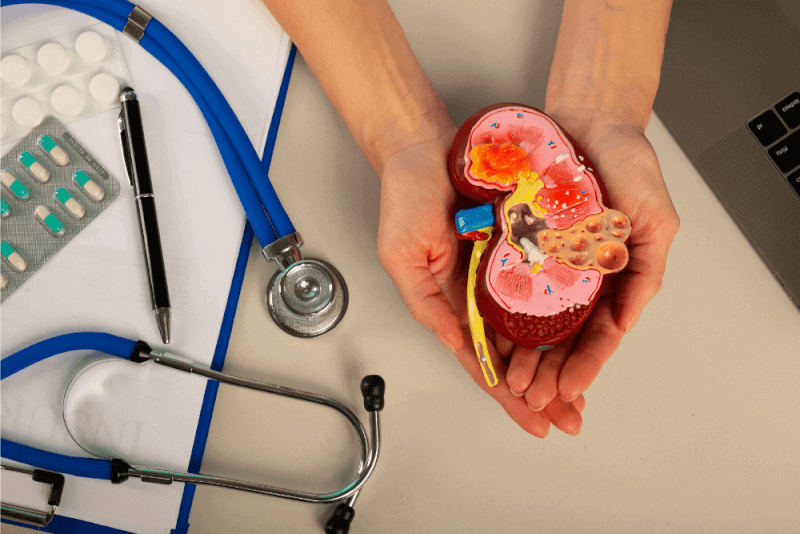30 Second Summary
- Leukemia is a type of cancer caused by the uncontrolled proliferation of stem cells in the bone marrow.
- Leukemia is characterized by overproduction of white blood cells (leukocytes).
- Acute leukemia is a type of cancer that progresses rapidly and can be fatal if left untreated.
- Chronic leukemia is a type of cancer that progresses more slowly and responds better to treatment.
What is leukemia?
Leukemia, which ranks first among childhood cancers, can be briefly defined as blood cancer. In detail, it is the uncontrolled proliferation of white blood cells in the bone marrow, which are not fully matured, as a result of stunted development of stem cells in the bone marrow due to some reasons.
Blood cancer occurs primarily in the bone marrow and can later metastasize to the lymph nodes, liver, brain and central nervous system. Leukemia is one of the fastest progressing and most malignant cancers. If the white blood cells mature fully during the uncontrolled increase, then the disease progresses more slowly.
Leukemia diagnosis methods
Many tests are needed to diagnose leukemia. The diagnostic process can therefore be lengthy. However, these tests not only diagnose the disease, but also determine its stage and type. This allows a treatment plan to be created quickly.
In the diagnosis of leukemia, the doctor must first perform a detailed physical examination. During this examination, physical changes due to anemia are looked for. These physical changes include enlarged liver, swollen lymph nodes and enlarged spleen.
Afterwards, patients undergo a complete blood count, biochemical and metabolic values, blood clotting tests and liver function tests. In addition, peripheral blood count and bone marrow biopsy are also important for diagnosis.
Bone marrow aspiration biopsy is extremely important for the diagnosis of acute leukemia. In the diagnosis of chronic leukemia, peripheral blood evaluation is usually sufficient. Therefore, a biopsy is not necessary. In addition, genetic diagnostic methods can also be used in the diagnosis of chronic leukemia.
Bone marrow biopsy usually involves taking a sample from the hip bone. During this procedure, a long needle is used and the sample taken with this needle is examined in the laboratory.
Symptoms of leukemia
Symptoms of leukemia can be similar to those of other bone marrow diseases. Symptoms seen in leukemia include the following:
- Fatigue
- Pallor
- Quick fatigue
- Shortness of breath
- Frequent infections
- Nosebleeds
- Bleeding gums
- Unexpected bruising under the skin
- Pinhead-sized rashes on the skin
- Loss of appetite
- Weight loss
- Night sweats
- Bone pain
- Enlarged neck and axillary lymph nodes
- Swelling of the gums
- Abdominal bloating
In addition to these symptoms, if the leukemia metastasizes, symptoms of the organ involved can also be seen. Therefore, in addition to the symptoms mentioned above, other symptoms may also be observed.
Causes of leukemia
Leukemia accounts for 35% of childhood cancers. For this reason, it is the most common childhood cancer. In addition, it is 1.5 times more common in men than in women and ranks 11th in the death rate due to cancer. ranks first. The causes of leukemia have not been established. However, risk factors are known for each type.
Acute lymphoblastic leukemia
The root cause of acute lymphoblastic leukemia, abbreviated ALL, has not yet been established. However, it has been observed that it is more common in people living in areas close to nuclear explosion sites. Radiation exposure must therefore be taken into account.
There is also a link between ALL and certain chemicals in cigarette smoke and chemotherapy drugs commonly used in cancer treatment.
Another risk factor for ALL is that people infected with EBV and HTLV-1 also have a higher incidence of ALL. Finally, people with Klinefelter syndrome, Down syndrome, neurofibromatosis and Fanconi anemia are at increased risk.
Acute myeloid leukemia
The cause of AML has been identified as genetic. For this reason, AML is caused by abnormalities and mutations in the DNA sections of stem cells in the bone marrow that are involved in their division and development. The likelihood of developing AML is directly proportional to age. For this reason, AML is diagnosed on average at the age of 68. AML is more common in men, and factors such as Down syndrome and smoking increase the risk.
Chronic lymphocytic leukemia
The cause of CLL is also not yet fully understood. However, age, being male, family history and exposure to chemical weapons used in wars are known to increase the risk.
Chronic myeloid leukemia
CML is caused by mutations in DNA. However, the cause of these mutations is not yet understood. Because it is caused by genetic mutations, people do not inherit these genes from their families and mutations occur during their lifetime. In this mutation, chromosome 9 becomes longer than normal, while chromosome 22 becomes shorter than normal.
Leukemia treatment
Before leukemia can be treated, the type and stage of the disease must first be determined.
Chemotherapy
As with other types of cancer, chemotherapy is the first option that comes to mind when it comes to treatment in leukemia. Chemical drugs given with chemotherapy destroy the cells that cause cancer. For this reason, the types and doses of drugs to be used in chemotherapy vary according to the type and stage of leukemia.
Some patients receiving chemotherapy require supportive treatment. Especially in acute leukemia patients, healthy blood cells are also affected by chemotherapy drugs, which can lead to bleeding and increased anemia. For this reason, these patients may need to be supplemented with antibiotics and transfusions of blood and blood products during chemotherapy. In addition to these medications, fungal treatment may be initiated as their immune system is weakened and medications may be prescribed to relieve nausea caused by chemotherapy.
Tyrosine kinase inhibitor with the active substance imatinib
This drug developed for CML patients is much more effective than chemotherapy drugs. Because it is effective against mutated genes and their products. In addition, it causes far fewer side effects than chemotherapy drugs.
Radiotherapy
Radiotherapy, also called radiotherapy, degenerates leukemia cells and prevents their growth. This method, which is applied using high-energy rays, can be applied to a certain part of the body or to the whole body. Another area where radiotherapy is used is in preparation for bone marrow transplantation.
Biological agents and immunotherapy drugs
The aim of these drugs is for the patient's immune system to attack and destroy cancerous cells. This allows malignant cancer cells to be better detected by the immune system and eliminated more effectively.
Bone marrow transplant
The most effective treatment for leukemia is bone marrow transplantation. In bone marrow transplantation, the patient's unhealthy bone marrow is replaced with healthy bone marrow. However, before this procedure, patients must be immunosuppressed with high doses of radiotherapy and chemotherapy. After immunosuppression, infusion of blood-forming stem cells is performed. The aim is to rebuild the bone marrow with these stem cells.
Bone marrow transplantation is recognized as one of the major medical procedures. In addition, bone marrow recipients may experience some side effects during marrow transplantation. These side effects include shortness of breath, sudden drop in blood pressure, chills, nausea, chills, vomiting and fever. In addition to these side effects, donors may also experience more serious side effects. The occurrence of serious side effects is influenced by the patient's general state of health, age and the reason for bone marrow harvesting.
GVHD can occur in bone marrow transplants. In this case, the donor's blood cells fight against the patient's blood cells. It is therefore an important health problem. Because if GVHD occurs, side effects such as transplant rejection, bleeding and internal organ damage can occur.
Types of leukemia
Leukemia is basically divided into two groups. The first is the type that progresses rapidly and causes clinical symptoms in a short period of time and is called acute leukemia. The other has a slow course and can take years to show clinical signs and is called chronic leukemia.
In acute leukemia, blood cells do not fully mature. They therefore multiply faster and are dysfunctional. These cells are called blasts. The rapid proliferation of blast cells leads to a rapid shrinking of the living space of healthy cells. For this reason, symptoms appear in a short time.
Both acute and chronic leukemia are divided into two branches according to the type of white blood cell. If the white blood cell is myeloid, it is called myeloid leukemia; if the white blood cell is a lymphocyte, it is called lymphoblastic.
Acute myeloid leukemia is common in children. In adults, acute myeloid and chronic lymphocytic leukemia are seen. Leukemia is basically divided into 4 subcategories.
Acute lymphoblastic leukemia (ALL)
ALL, which occurs in approximately 80% of pediatric patients, is a type of cancer caused by the proliferation of white blood cells before they complete their development. It accounts for 20% of leukemia cases in adults. The 5-year survival rate for ALL is 63%.
The symptoms of ALL are similar to those of other types of leukemia. There is no staging of ALL in adults. ALL is treated with chemotherapy, radiotherapy, stem cell transplantation and immunotherapy.
Acute myeloid leukemia (AML)
AML, especially in leukemia patients in their early 20s, is a type of leukemia caused by the uncontrolled proliferation of blast cells of myeloid origin. Approximately half of all leukemia cases are AML. It is also the most common type of leukemia detected in adults and has a 5-year survival rate of 26%.
AML risk factors include the following:
- Having myelodysplastic syndrome
- Exposure to cigarette smoke
- Radiation exposure
- Exposure to chemical substances
- Male gender
- Previous radiotherapy or chemotherapy treatment
The symptoms of AML are similar to those of ALL. Bone marrow aspiration is required for a definitive diagnosis. AML is diagnosed if the blast count in the sample is above 20%.
AML Stages
There is no staging in AML. Instead of staging, the disease process is divided into 3 groups. The first of these groups is untreated AML. Patients in this group are newly diagnosed and have not yet started treatment.
AML in remission means the absence of blasts in the bone marrow. During this process, the bone marrow regains its former functions. For this reason, it can also be called the recovery period of the disease.
Finally, in the process of relapsed AML, blast cells are regenerated in a patient who first goes into remission.
Chronic lymphocytic leukemia (CLL)
It is caused by the maturation and subsequent uncontrolled proliferation of white blood cells of lymphoid origin. Although these white blood cells have completed their maturation, they are unable to function. The 5-year survival rate for CLL, which usually occurs in people between the ages of 60 and 70, is approximately 83%.
CLL is extremely benign compared to ALL and does not occur in children. In 95% of these patients, the leukemic change occurs in the B lymphocyte. The remaining patients have T lymphocytes or natural killer cells.
Symptoms of CLL are not seen in the early stages. However, increased white blood cells are considered a warning sign. Otherwise, the symptoms are similar to other diseases. These symptoms include the following:
- Quick fatigue
- Shortness of breath while performing normal activities
- Enlargement of lymph nodes
- Enlargement of the spleen
- Infections
- Weight loss
- Fire
- Night sweats
CLL stages
CLL stages are divided into five:
- In stage 0, patients are diagnosed incidentally because there are no symptoms. Increased lymphocyte cells at this stage are the decisive diagnosis.
- In stage 1, lymphocyte counts increase as well as lymphocyte counts increase. enlargement of the glands is also observed.
- In stage 2, among other symptoms, patients have enlarged spleens.
- In stage 3, patients begin to experience anemia.
- In stage 4, patients experience a decrease in platelet counts.
Chronic myeloid leukemia (CML)
Seen in adults between 25 and 60 years of age, CML is caused by the uncontrolled proliferation of white blood cells of myeloid origin. In the CML variant of leukemia, the 5-year survival rate is 67%.
The most characteristic sign of CML is an increase in granulocyte-type cells. However, these cells cannot function due to abnormalities in their structure. This is why these cells are called leukemic cells.
The onset of symptoms in CML patients begins when abnormal cells proliferate to such an extent that there is no space for healthy cells. In CML, which is more common in men than in women, there is an increase in blood platelets that provide blood clotting. Since this clotting is also seen in the spleen, enlargement of the spleen is also seen in the following period. In addition, symptoms seen in CML patients include the following:
- Feeling of fullness and pain under the left rib caused by an enlarged spleen
- Night sweats
- High fever
- Weight loss
- Fatigue and weakness when performing daily activities
CML phases
Phases rather than stages are used in the classification of CML. In order to determine the treatment correctly, it is necessary to determine which phase the patient is in.
- 85% of patients are diagnosed in the chronic phase. In this phase, symptoms are almost non-existent and the blast cell rate in the blood sample of patients is 10%. The chronic phase is a slowly progressing phase and usually does not require hospitalization. A significant proportion of patients remain in the chronic phase for 3 to 4 years and continue their normal lives.
- The second phase of CML is the accelerated phase, the accelerated phase. The blast cell rate in patients in this phase varies between 10% and 19%. In addition to the fact that 10% of patients are diagnosed at this stage, symptoms include weight loss, splenomegaly, fever and bone pain.
- The last phase of CML is the blastic phase. In patients in this phase, the proportion of blast blood cells has exceeded 20% and therefore it turns into acute leukemia. Symptoms seen in patients during this phase include severe bone pain, skin bruising, blast crises, fever, weakness and fatigue. In some cases, leukocyte counts are very high in patients diagnosed in this phase. Therefore, the normal flow of blood cannot be ensured. As the blood cannot flow normally, abnormally proliferating cells leak into the tissues, posing a risk to life. In this case, patients receive a treatment called leukopheresis. In this treatment, patients' blood is filtered to remove leukocytes. However, this treatment cannot be applied if the leukocyte level exceeds the critical value.
Hairy cell leukemia
In hairy cell leukemia, a slowly progressing form of CLL, short extensions form on the surface of lymphocytes. As these cells accumulate in the bone marrow, not enough blood cells can be produced. Due to the lack of sufficient blood cells, patients have anemia and an increased risk of infection. In addition, bruising can be seen on the skin even after minor blows.
Hairy cell leukemia is usually diagnosed when a doctor is consulted because of an infection. Besides being defined as abnormal B lymphocytes, they do not cause enlargement of lymph nodes. But it accumulates in the bone marrow, spleen and liver. For this reason, the diagnosis requires an enlarged spleen and a significant decrease in blood cell count. The most effective treatment for hairy cell leukemia is removal of the spleen.









